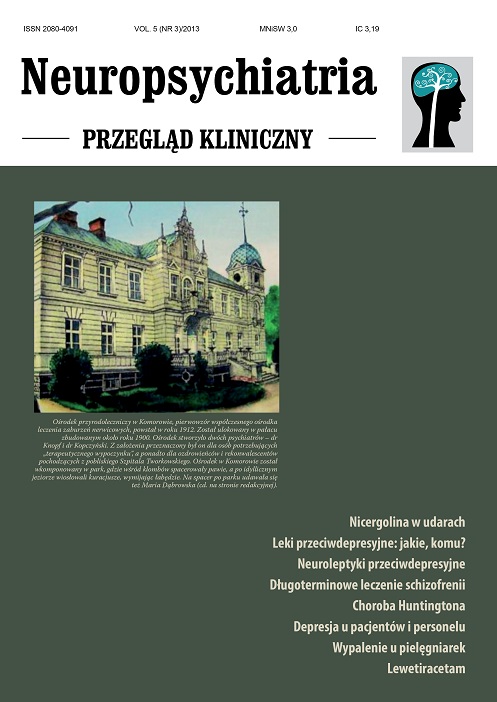Neuroleptyki działające przeciwdepresyjnie Artykuł przeglądowy
##plugins.themes.bootstrap3.article.main##
Abstrakt
Do leczenia epizodów depresyjnych możemy zastosować wiele leków przeciwdepresyjnych. Jednak szereg kontrolowanych badań, metaanaliz i praktycznych badań wykazało, że zaledwie mniejszość pacjentów z depresją może liczyć na remisję wskutek właściwie prowadzonego leczenia środkami przeciwdepresyjnymi. Co więcej, antydepresanty okazały się nieefektywne lub niebezpieczne u pacjentów z depresją w przebiegu zaburzenia dwubiegunowego. Zaproponowano szereg koncepcji dla przezwyciężenia tych braków skuteczności. Ostatnio w odniesieniu do neuroleptyków II generacji, przede wszystkim olanzapiny i kwetiapiny, potwierdzono skuteczność w leczeniu zaburzeń depresyjnych u pacjentów jedno- i dwubiegunowych. W tym przeglądzie zaprezentowano całościowy obraz badań klinicznych nad wykorzystaniem neuroleptyków II generacji w leczeniu zaburzeń depresyjnych oraz związanych z tym kwestii farmakologicznych.
##plugins.themes.bootstrap3.article.details##

Utwór dostępny jest na licencji Creative Commons Uznanie autorstwa – Użycie niekomercyjne – Bez utworów zależnych 4.0 Międzynarodowe.
Copyright: © Medical Education sp. z o.o. License allowing third parties to copy and redistribute the material in any medium or format and to remix, transform, and build upon the material, provided the original work is properly cited and states its license.
Address reprint requests to: Medical Education, Marcin Kuźma (marcin.kuzma@mededu.pl)
Bibliografia
2. Buna M. Pozarejestracyjne zastosowanie kwetiapiny w leczeniu bezsenności. Neuropsychiatria. Przegląd Kliniczny 2012; 4(4): 178-181.
3. Cerullo MA, Strakowski SM. A systematic review of the evidence for the treatment of acute depression in bipolar I disorder. CNS Spectr. 2013; 18(4): 199-208.
4. Łoza B, Broma J. Refractory depression treated with clozapine. Int J Neuropsychopharmacol 2004; 7: 354.
5. Tohen M, Katagiri H, Fujikoshi S et al. Efficacy of olanzapine monotherapy in acute bipolar depression: a pooled analysis of controlled studies. J Affect Disord 2013; 149(1-3): 196-201.
6. Thase ME, Corya SA, Osuntokun O et al. A randomized, double- blind comparison of olanzapine/fluoxetine combination, olanzapine, and fluoxetine in treatment-resistant major depressive disorder. J Clin Psychiatry 2007; 68(2): 224-236.
7. Łoza B. Vademecum kwetiapiny. Neuropsychiatria. Przegląd Kliniczny 2013; 5(2): 103-111.
8. Bauer M et al. Results from a phase III study of extended release quetiapine fumarate (quetiapine XR) as add-on to antidepressants in patients with major depressive disorder (MDD). International Forum on Mood and Anxiety Disorders, Budapeszt, Węgry, 5-7 grudnia 2007.
9. Montgomery S et al. A randomised, placebo-controlled study of once-daily extended release quetiapine fumarate (quetiapine XR) monotherapy in patients with major depressive disorder (MDD). International Forum on Mood and Anxiety Disorders, Budapeszt, Węgry, 5-7 grudnia 2007.
10. Tohen M, Calabrese J, Vieta E et al. Effect of comorbid anxiety on treatment response in bipolar depression. J Affect Disord 2007; 104(1-3): 137-146.
11. McElroy SL, Weisler RH, Chang W et al.; EMBOLDEN II Investigators. A double-blind, placebo-controlled study of quetiapine and paroxetine as monotherapy in adults with bipolar depression (EMBOLDEN II). J Clin Psychiatry 2010; 71(2): 163-174.
12. Croxtall JD, Scott LJ. Olanzapine/fluoxetine: a review of its use in patients with treatment-resistant major depressive disorder. CNS Drugs 2010; 24(3): 245-262.

